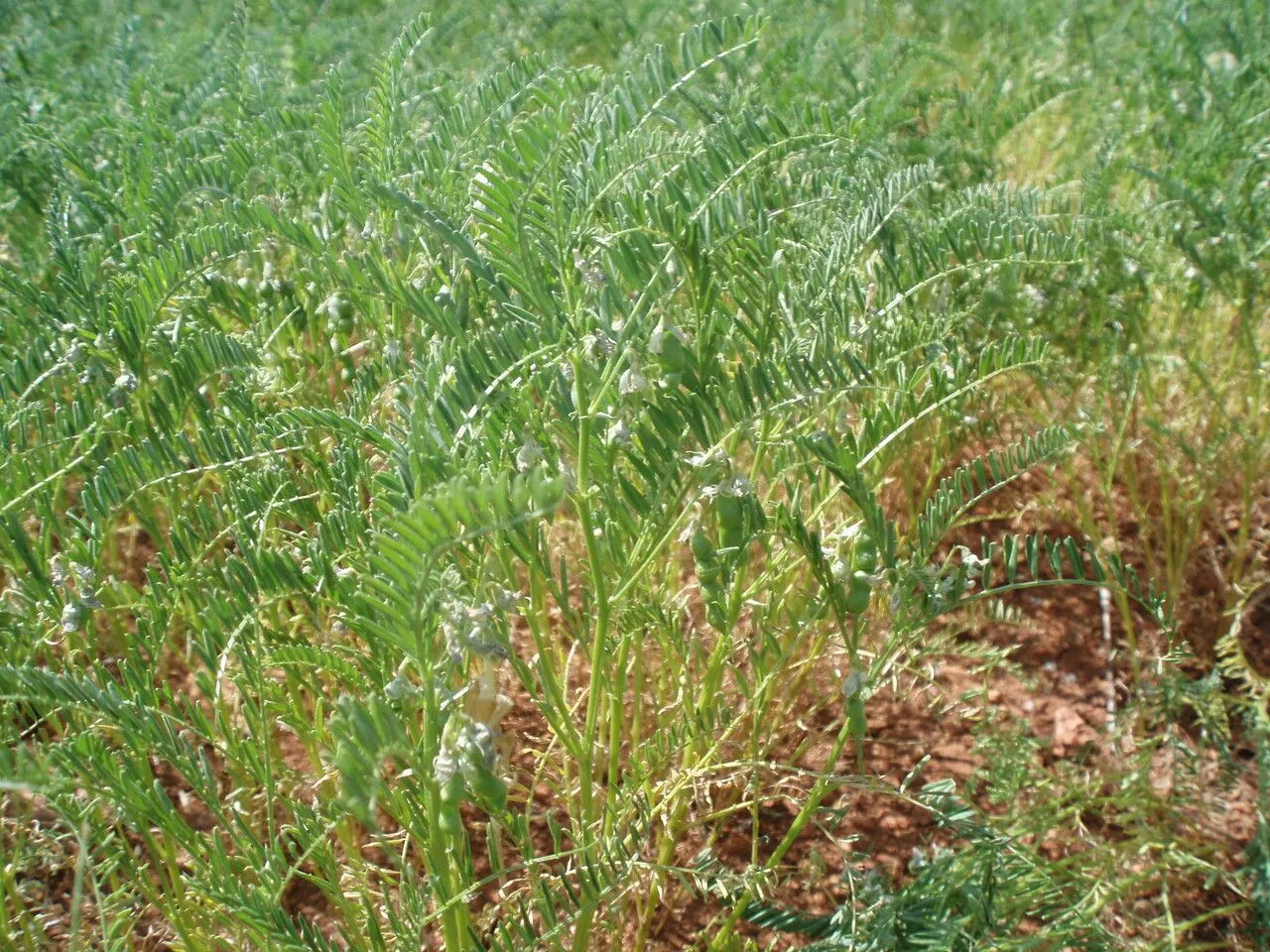
Author: (L.) Willd.
Bibliography: Sp. Pl., ed. 4, 3: 1103 (1802)
Year: 1802
Status: accepted
Rank: species
Genus: Vicia
Vegetable: False
Observations: Medit. to C. Asia
Bitter vetch, scientifically known as Vicia ervilia, belongs to the Fabaceae family. This leguminous plant, identified and classified by the renowned botanist Willdenow in the fourth edition of “Species Plantarum” in 1802, is a species deeply rooted in the agricultural history of the Mediterranean region, stretching all the way to Central Asia.
Renowned for its resilience and adaptability, Bitter vetch thrives in a variety of climates and soils, showcasing its hardiness across diverse geographies. Historically, it has been a crucial crop for ancient and modern civilizations alike, owing to its nutritional benefits and versatility. The seeds of Vicia ervilia have been employed primarily as livestock feed, providing a rich protein source that is particularly valuable during times of scarcity.
The plant itself exhibits typical leguminous characteristics, contributing to soil fertility through nitrogen fixation—a process that enriches the soil with essential nutrients, making it a sustainable option for crop rotation practices. This agronomic trait underscores the ecological importance of Bitter vetch in maintaining and restoring the fertility of agricultural lands.
In addition to its agronomic benefits, Bitter vetch also holds a place in traditional medicine and culinary practices in various cultures. Its seeds, albeit bitter, are sometimes used in local cuisines after appropriate preparation to diminish their inherent bitterness.
The geographical distribution of Vicia ervilia, spanning from Mediterranean regions to Central Asia, highlights its wide adaptability and significant role in sustaining agrarian lifestyles in these parts of the world. Its enduring presence in these regions is a testament to its utility and the vital ecological services it provides.
In summary, Bitter vetch (Vicia ervilia) is a plant of great agricultural significance and ecological value, with a rich history tethered to its Mediterranean and Central Asian origins. Its contributions to soil health, dietary protein supply for livestock, and its minor role in human culinary practices, underscore its multifaceted benefits.
Fra: ervilier, lentille bâtarde, alliez, ers, erse, ervilière, pois de pigeon, vesce bâtarde
Deu: linsen-wicke, linsenwicke, steinlinse
Dan: perle-vikke
Spa: alacarceña, ervilha-de-plomo, gero, yeros
Eng: bitter vetch, blister vetch, ervil
Por: ervilha-de-pombo, ervilheira-de-pombo, gero, orobo
Swe: linsvicker
Est: lääts-hiirehernes
Ces: vika šošovicová, vikev
Mlt: żosfa
Nld: linzenwikke/erve
En: Bitter vetch, Ervil, Blister vetch
Ar: دحريج (دُحريج)، جلبان (جِلبان، جُلُبان), Kirsannah
Ca: Erb
Cs: Vika šošovicová, Vikev
Da: Perle-vikke
Nl: Linzenwikke/Erve, Linzenwikke
Et: Lääts-hiirehernes
Fr: Ervilière, Pois de pigeon, Alliez, Ers, Erse, Vesce bâtarde, Ervilier, Lentille bâtarde, Lentille du Canada, Vesce ervilia
De: Linsenwicke, Steinlinse, Linsen-Wicke
He: בקיית הכרשינה
It: Mochi, Veccia capogirlo, Vecciola, Capogirlo, Ervo, Veccioli
Mt: Żosfa
Pt: Ervilha-de-pombo, Gero, Orobo, Ervilheira-de-pombo
Ru: Francuzskaja čečevica
Es: Yeros, Alacarceña, Ervilha-de-plomo, Gero, Alcarceña, Alcarraceña, Alcaruna, Alverja, Ervilla, Lenteja bastarda, Yero, Vicia ervilia, Yerbo
Sv: Linsvicker
Taken Apr 29, 2020 by Jiri Vodrazka (cc-by-sa)
Taken Apr 30, 2022 by Basabe Zaloa (cc-by-sa)
Taken May 17, 2012 by LUCAS survey – European Union (©)
Taken Jun 1, 2018 by LUCAS survey – European Union (©)
Taken May 7, 2015 by LUCAS survey – European Union (©)
Taken Aug 15, 2005 by Photoflora – Jean-Luc TASSET (©)
Taken Apr 15, 2007 by Photoflora – Jean-Luc TASSET (©)
Taken Aug 15, 2005 by Photoflora – Jean-Luc TASSET (©)
Taken Apr 26, 2021 by Helen Pansecos (cc-by-sa)
Taken May 1, 2019 by Mehmet Basbag (cc-by-sa)
Taken May 9, 2021 by Blas Ramos (cc-by-sa)
Taken Jun 7, 2020 by lafuente fernando (cc-by-sa)
Taken May 15, 2017 by Photoflora – Benoit BOCK (©)
Taken Jun 3, 2018 by LUCAS survey – European Union (©)
Taken May 20, 2015 by LUCAS survey – European Union (©)
Taken Apr 29, 2015 by LUCAS survey – European Union (©)
Taken Apr 30, 2015 by LUCAS survey – European Union (©)
Taken May 29, 2012 by LUCAS survey – European Union (©)
Taken May 18, 2012 by LUCAS survey – European Union (©)
Taken Apr 15, 2007 by Photoflora – Benoit BOCK (©)
Taken May 15, 2017 by Photoflora – Benoit BOCK (©)
Taken Jan 1, 1970 by Photoflora – L’Abbé COSTE (©)
© copyright of the Board of Trustees of the Royal Botanic Gardens, Kew.
© copyright of the Board of Trustees of the Royal Botanic Gardens, Kew.
© copyright of the Board of Trustees of the Royal Botanic Gardens, Kew.
Growth habit>: Vine, Forb/herb
Ph maximum: 7.5
Ph minimum: 7.0
Light: 7
Atmospheric humidity: 4
Bloom months: [‘may’, ‘jun’, ‘jul’, ‘aug’]
Soil nutriments: 6
Family: Myrtaceae Author: (F.Muell.) K.D.Hill & L.A.S.Johnson Bibliography: Telopea 6: 402 (1995) Year: 1995 Status:…
Family: Rubiaceae Author: Pierre ex A.Froehner Bibliography: Notizbl. Bot. Gart. Berlin-Dahlem 1: 237 (1897) Year:…
Family: Sapindaceae Author: Koidz. Bibliography: J. Coll. Sci. Imp. Univ. Tokyo 32(1): 38 (1911) Year:…
Family: Asteraceae Author: A.Gray Bibliography: Pacif. Railr. Rep.: 107 (1857) Year: 1857 Status: accepted Rank:…
Family: Fabaceae Author: Medik. Bibliography: Vorles. Churpfälz. Phys.-Ökon. Ges. 2: 398 (1787) Year: 1787 Status:…
Family: Aspleniaceae Author: (Cav.) Alston Bibliography: Bull. Misc. Inform. Kew 1932: 309 (1932) Year: 1932…